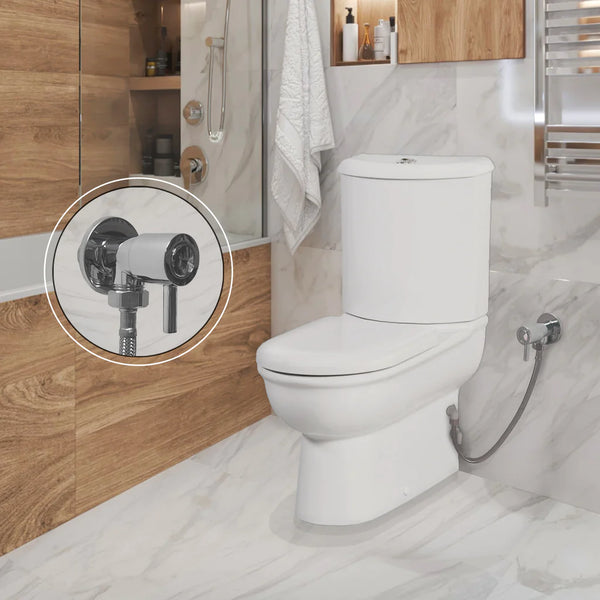Back-to-Wall vs. Close-Coupled Toilets: Choosing the Right Style for Your Bathroom
Posted by ilker Duymaz on
When it comes to renovating a bathroom or choosing fixtures for a new build, the selection of the toilet can significantly impact the overall aesthetic, functionality, and comfort of the space. Among the various styles available, back-to-wall and close-coupled toilets stand out as popular choices, each offering distinct benefits and considerations. This article will delve into the comparison between these two toilet types, helping you make an informed decision for your bathroom.
Back-to-Wall Toilets: Sleek and Modern

Back-to-wall toilets feature a design where the toilet pan sits flush against the bathroom wall or unit, hiding the cistern and pipework. This style is favoured for its sleek and unobtrusive look, contributing to a minimalist and tidy bathroom aesthetic.
- Aesthetic Appeal: With the cistern concealed, back-to-wall toilets offer a cleaner look, enhancing the bathroom's modern feel.
- Space-Saving: Ideal for smaller bathrooms, as the concealed cistern saves space.
- Easier Cleaning: Less exposed pipework means there are fewer places for dust and grime to accumulate.
Cons:
- Installation Complexity: Requires a bit more work to install due to the concealed cistern.
- Maintenance Access: Accessing the cistern for repairs or maintenance can be more challenging.
Close-Coupled Toilets: Classic and Convenient

Close-coupled toilets, where the cistern sits directly on top of the toilet pan with the flush mechanism between them, are the most common type found in homes today. They are appreciated for their traditional design and straightforward installation.
- Cost-Effective: Generally, close-coupled toilets are less expensive than back-to-wall models.
- Ease of Installation: They are easier to install, with no need to modify the wall or install a concealed cistern.
- Maintenance Simplicity: With the cistern visible and easily accessible, repairs and maintenance are more straightforward.
Cons:
- Space Requirement: They can take up more space, which might not be ideal for very small bathrooms.
- Cleaning Difficulty: The external cistern and pipes may collect dust and require more effort to clean around.
Making Your Choice
The decision between a back-to-wall and a close-coupled toilet will largely depend on your bathroom's size, your aesthetic preferences, budget, and practical considerations regarding installation and maintenance.
- For those prioritizing a modern look and have a smaller space, a back-to-wall toilet may be the ideal choice.
- If you prefer a classic design, are working with a larger room, or have a tight budget, a close-coupled toilet might be more suitable.
Regardless of your choice, both options offer reliable functionality and can be found in a range of designs to suit any bathroom style.
For more insights into making the best bathroom fixture choices, don't forget to explore our comprehensive comparisons, including Back-to-Wall vs. Wall-Hung Toilets, and the advantages of Bidet Toilets over traditional models. These resources will equip you with the knowledge to create a bathroom that not only meets your functional needs but also reflects your personal style and comfort preferences.
Choosing the right toilet is a crucial aspect of bathroom design that affects daily use, cleanliness, and overall satisfaction with your space. By considering the differences between back-to-wall and close-coupled toilets, you can select the option that best fits your needs, ensuring a combination of style, comfort, and practicality in your bathroom.




